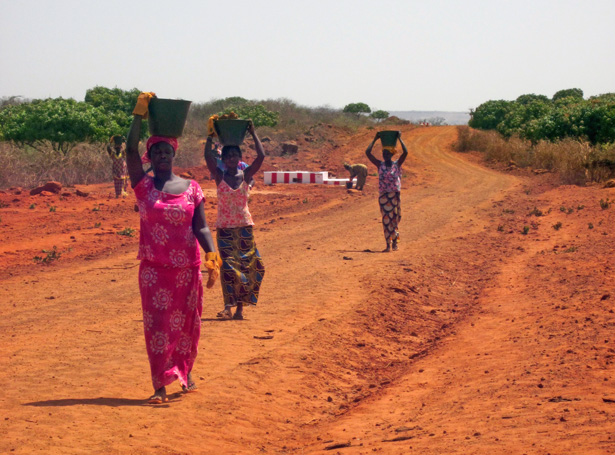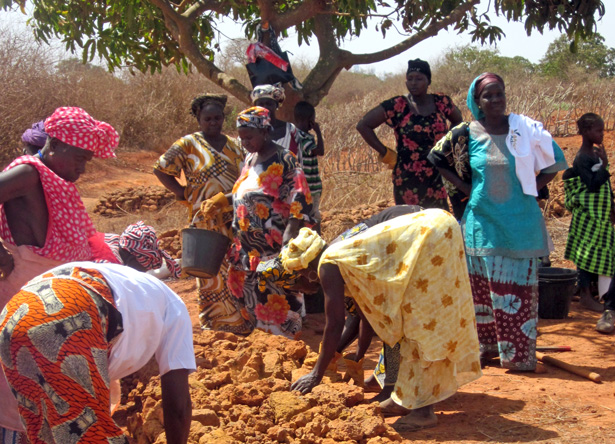-
From Dakar to Abidjan, Population Finally Finding Its Place in Food Security Assessments
June 20, 2013 By Kathleen MogelgaardA woman sat crouched on the side of a busy road in Dakar, a baby in a sling on her back and a basket of peanuts in front. I know only a little French, and no Wolof, but I decided to try anyway. “Bonsoir,” I said, and smiled at the toddler beside her. “Combien?” I asked, pointing at the peanuts.
She smiled back at me, we negotiated a sale, and in exchange for the coins in my pocket I walked away with a few bags of the small, tasty nuts that are grown throughout the “peanut basin” of central Senegal.
I was in Senegal learning how farmers are coping with climate change. About 70 percent of the population is employed in the agricultural sector, and most of the crops they grow – including groundnuts and millet – are rain-fed. Many farmers are already struggling with extremely variable rainfall, a pattern that is likely to be exacerbated by a changing climate.
The fragility of Senegal’s agriculture contributes to the country’s food security challenges. Under-nutrition is a moderate but persistent problem, with about 16 percent of children under five suffering from stunting. The U.S. Agency for International Development has targeted Senegal as 1 of 19 priority countries for its Feed the Future food security initiative.
How Many Mouths to Feed?
Rapid population growth is also a factor in Senegal’s ability to achieve food security. According to demographic projections, Senegal’s population will grow from 13 million today to somewhere between 29 and 37 million by 2050. That’s a fairly wide range – and the path of growth within that range is likely to be an important factor in shaping future food security outcomes.
Senegal, like most West African countries, has both rapid population growth and high proportions of women who would like to avoid pregnancy but aren’t using family planning. For most countries in the region, more than 30 percent of women report an unmet need for family planning. Meeting this demand would not only yield tremendous health and economic benefits, but would also bend population projections toward more manageable ranges in terms of meeting future food requirements.
The fact that future population growth can take different pathways is rarely acknowledged in analyses of food security. It is even less common for analysts or policymakers to consider how meeting women’s needs for reproductive health and family planning can affect the population scenarios that have such significance for food security outcomes. However, there is new and encouraging evidence that this is starting to change.
Adding Population to the Equation
West African Agriculture and Climate Change, published earlier this year by the International Food Policy Research Institute (IFPRI), is a collection of papers that explores challenges to food security in Senegal and 10 other West African nations. Importantly, the authors use low, medium, and high population projections in their assessments and their recommendations include policies related to slowing growth. Of course their assessments are not limited to population dynamics: population projections are combined with various assumptions about economic growth and then used as inputs for models of climate change, agriculture, and human vulnerability. But the extent to which they include mention of demography – and in particular, the connection to family planning – is noteworthy.
The summary chapter reports the following, for example:
Unfortunately, the dismal level of family planning among the vast majority of the population in West Africa, particularly in rural areas, has resulted in a rapidly growing population that is not matched by the stagnant or slow increase in food production, which largely remains in the hands of smallholders who lack the vital inputs to deal with the growing challenges of the climate.
And, in addition to more traditional recommendations such as establishing weather stations to provide forecast data to farmers; development of new crop varieties and techniques that are resilient to climate shocks; and strengthening safety net policies on food and nutrition security for vulnerable groups, some of the country chapters include specific population-related recommendations.
For Benin, the authors urge policymakers to “take adequate steps to slow population growth and thus avoid imposing tremendous pressure on the nature resource base for food production.”
They encourage the government of Cote d’Ivoire to formulate and support policies that directly support agricultural adaptation, in addition to “providing support for family planning and other interventions to slow population growth, which might reduce the demand for food and enhance food security for the nation.”
In Liberia, the authors note “major challenges associated with population growth include dilapidated infrastructure, a weak health system, malnutrition, a lack of clean drinking water, bad road conditions, and high levels of unemployment.” And one of their six recommendations for the government is to “develop policies to address the challenges associated with population growth.”
And among the recommendations from the authors of the study on Sierra Leone is the need for policymakers to “take appropriate measures to control the rapid increase in population as well as to provide appropriate infrastructure, social services, and mechanization of agriculture in the rural areas to slow massive movements of youth into urban areas.”
Women on the Front Lines
The recognition in IFPRI’s analyses that population growth does not follow a fixed trajectory into the future is a welcome development and could help pave the way for more holistic responses to food security challenges.
In paving that path, however, it is critical to remember that addressing population from a rights-based perspective is not simply about crunching numbers or handing out contraceptives. Understanding women’s lives, expanding their options, and dismantling obstacles to their empowerment must be a part of policy and programmatic responses. Empowering women in this way – not just in West Africa but all around the world – is not simply a matter of supply and demand, but involves a contextual understanding of women’s lives.
The day after my peanut purchase in Dakar, I traveled about 60 kilometers west of the capital to Keur Moussa, a small farming community. Or rather, it used to be a farming community. In recent years, drought, declining soil fertility, and erosion resulting from heavy downpours and high winds have driven most of the men from the fields to the city in search of paid work. The women who are left behind are doing what they can to address soil erosion so that they can grow enough food to feed their families.
These women have joined together in the construction of low-tech engineering projects to keep water and soil close to home. They carry rocks in buckets on their heads to build dikes in areas where flood waters periodically sweep away earth; they wield pickaxes to carve out basins to store water from heavy downpours; they plant natural windbreaks to shield their vegetable gardens. Like their urban counterpart selling peanuts, they often do this work with a baby in a sling or a toddler at their heels. They are doing what they can to adapt, but they worry about their children’s future.
These are the women on the front lines of efforts to achieve food security in a changing climate. Involving them in decision-making and strategy development for climate change adaptation and food security will help to ensure that solutions are effective and sustainable. Ensuring that they have access to the information and services they need to make decisions about their reproductive lives will have a significant impact on how they feed their children and meet the challenges of climate change. When they are empowered, the prospects for achieving food security for all will look a lot more hopeful.
Kathleen Mogelgaard is a writer and analyst on population and the environment, and a consultant for the Environmental Change and Security Program.
Sources: Adaptation Learning Mechanism, Feed the Future, International Food Policy Research Institute, UN Population Division, UNFPA, Women’s Environment and Development Organization.
Photo Credit: Women building earthen anti-erosion walls in the village of Keur Moussa, Senegal, used with permission courtesy of Kathleen Mogelgaard.
 A Publication of the Stimson Center.
A Publication of the Stimson Center.





